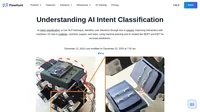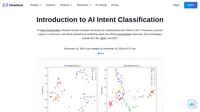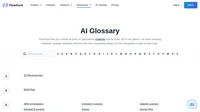Natural Language Understanding (NLU) is a subfield of artificial intelligence (AI) that focuses on a machine’s ability to comprehend and interpret human language in a meaningful way. Unlike basic text processing or keyword matching, NLU aims to understand the context, intent, and nuances behind the words that humans use, enabling computers to interact with users more naturally and effectively.
Understanding Natural Language Understanding
Natural language is the way humans communicate with each other using spoken or written words in languages like English, Mandarin, or Spanish. These languages are complex, filled with idioms, ambiguities, and contextual meanings that are often challenging for computers to grasp. NLU tackles these challenges by enabling machines to interpret human language at a level that goes beyond literal word-by-word translation.
NLU vs. NLP vs. NLG
NLU is often confused with other related terms in the field of AI, such as Natural Language Processing (NLP) and Natural Language Generation (NLG). While they are interconnected, each serves a distinct purpose:
- Natural Language Processing (NLP): NLP encompasses all aspects of understanding and processing human language by machines. It includes both understanding and generating language, covering various techniques to process and analyze large amounts of natural language data.
- Natural Language Understanding (NLU): NLU is a subset of NLP that focuses specifically on machine reading comprehension. It involves interpreting the meaning behind text or speech, recognizing intent, and handling the nuances of language such as context, sentiment, and ambiguity.
- Natural Language Generation (NLG): NLG is another subset of NLP that deals with generating human language from machine-readable data. It enables computers to create text or speech that mimics human communication, often used for summarizing information or responding to user queries.
Understanding the differences between these terms is essential for grasping how NLU fits into the broader field of AI and language processing.
How Does Natural Language Understanding Work?
NLU systems employ a combination of computational linguistics, machine learning algorithms, and semantic understanding to interpret human language. The process involves several key steps:
1. Tokenization
Tokenization involves breaking down the input text or speech into smaller units called tokens, which can be words, phrases, or symbols. This step makes it easier for the system to analyze the language structure.
Example:
Input sentence: “Book a flight to New York tomorrow.”
Tokens: [“Book”, “a”, “flight”, “to”, “New York”, “tomorrow.”]
2. Part-of-Speech Tagging
In this step, each token is labeled with its grammatical function, such as noun, verb, adjective, etc. Part-of-speech tagging helps in understanding the grammatical structure of the sentence.
Example:
- “Book” – Verb
- “a” – Article
- “flight” – Noun
- “to” – Preposition
- “New York” – Proper Noun
- “tomorrow” – Adverb
3. Syntactic Parsing
Syntactic parsing involves analyzing the grammatical structure of the sentence to understand how the tokens relate to each other. This step creates a parse tree that represents the syntactic structure.
4. Semantic Analysis
Semantic analysis interprets the meaning of the sentence by considering the definitions of words and how they combine in context. It resolves ambiguities and understands synonyms or homonyms.
Example:
The word “Book” could be a noun or a verb. In this context, it’s identified as a verb meaning “to schedule.”
5. Intent Recognition
Intent recognition identifies the purpose behind the user’s input. It determines what the user wants to achieve.
Example:
Intent: Booking a flight.
6. Entity Recognition
Entity recognition extracts specific data points or entities from the text, such as dates, times, locations, names, etc.
Example:
- Destination: New York
- Date: Tomorrow
7. Contextual Understanding
NLU systems consider the context of the conversation, including previous interactions, to provide accurate responses.
Example:
If earlier in the conversation the user mentioned they prefer morning flights, the system takes that into account.
8. Response Generation
Once the intent and entities are identified, the system can generate an appropriate response or action, often involving NLG to produce human-like text or speech.
Applications of Natural Language Understanding
NLU has a wide range of applications across various industries, enhancing the way humans interact with machines. Below are some prominent use cases:
1. Chatbots and Virtual Assistants
NLU is the backbone of intelligent chatbots and virtual assistants like Amazon’s Alexa, Apple’s Siri, Google Assistant, and Microsoft Cortana. These systems can understand voice commands or text inputs to perform tasks, answer questions, or control smart devices.
Use Case Example:
- Customer Support Chatbots: Companies implement chatbots on their websites to handle common customer queries. By understanding natural language, these chatbots can provide instant answers, troubleshoot issues, or guide users through processes without human intervention.
2. Customer Service and Support
NLU enhances customer service by enabling systems to interpret and respond to customer inquiries accurately.
Use Case Examples:
- Interactive Voice Response (IVR) Systems: NLU allows IVR systems to understand spoken requests, route calls to appropriate departments, or provide information without the need for touch-tone menus.
- Email Routing: NLU can analyze incoming customer emails to determine the intent and urgency, directing them to the appropriate support agents or triggering automated responses.
3. Sentiment Analysis
NLU is used to analyze text data from social media, reviews, or feedback to determine the sentiment behind customer opinions.
Use Case Example:
- Brand Reputation Management: Companies monitor social media platforms to gauge public sentiment about their products or services. NLU helps in categorizing comments as positive, negative, or neutral, allowing businesses to respond appropriately.
4. Machine Translation
NLU plays a significant role in translating text or speech from one language to another while preserving meaning and context.
Use Case Example:
- Global Communication: Businesses operating in multiple countries use NLU-powered translation tools to communicate with international clients and partners, ensuring accurate and contextually appropriate translations.
5. Voice-Powered Applications
NLU enables applications to understand and process voice commands, making interactions more natural.
Use Case Examples:
- Smart Home Devices: Users can control home appliances, lighting, or security systems using voice commands interpreted by NLU systems.
- Voice-Activated Search: NLU allows users to search the internet using natural speech, enhancing accessibility and convenience.
6. Content Analysis and Data Extraction
NLU assists in processing large volumes of unstructured text data to extract meaningful information.
Use Case Examples:
- Legal Document Analysis: Law firms use NLU to scan contracts or legal documents to identify key clauses, obligations, or risks.
- Medical Record Processing: NLU helps in extracting patient information, diagnoses, and treatment plans from unstructured medical notes.
7. Education and E-Learning
NLU enhances educational tools by enabling personalized learning experiences.
Use Case Example:
- Intelligent Tutoring Systems: NLU allows educational software to understand student queries and provide tailored explanations or resources.
Examples of NLU in Action
1. Virtual Assistants
- Apple’s Siri: Uses NLU to understand voice commands for setting reminders, sending messages, or searching information.
- Amazon’s Alexa: Interprets natural language to control smart home devices, play music, or answer questions.
- Google Assistant: Understands complex queries and provides personalized responses based on user preferences and context.
2. Customer Support Chatbots
- Banking Services: Chatbots assist customers with account inquiries, transaction details, or fraud reporting by understanding their questions in natural language.
- E-commerce Platforms: Bots help users track orders, process returns, or find products through conversational interfaces.
3. Sentiment Analysis Tools
- Social Media Monitoring: Tools like Brandwatch use NLU to analyze public sentiment on platforms like Twitter or Facebook, helping businesses understand customer attitudes.
4. Machine Translation Services
- Google Translate: Goes beyond word-for-word translation by using NLU to grasp context and provide more accurate translations.
- Microsoft Translator: Utilizes NLU to interpret idiomatic expressions and maintain the intended meaning across languages.
5. Data Capture and Forms Processing
- Automated Data Entry: NLU enables systems to understand information provided in natural language and populate databases or forms accurately.
- Voice-to-Text Applications: Transcribe spoken language into written text while understanding punctuation and formatting based on context.
Benefits of Natural Language Understanding
NLU brings several advantages that enhance both user experience and operational efficiency:
1. Improved Human-Computer Interaction
By enabling machines to understand natural language, interactions become more intuitive and user-friendly. Users don’t need to learn specific commands or syntax, making technology more accessible.
2. Automation of Routine Tasks
NLU allows for the automation of repetitive tasks such as answering FAQs, scheduling appointments, or processing standard requests, freeing up human resources for more complex activities.
3. Enhanced Customer Experience
Personalized and timely responses made possible by NLU lead to higher customer satisfaction. Understanding customer intent allows businesses to address needs effectively.
4. Insight from Unstructured Data
NLU can process large volumes of unstructured data like emails, reviews, and social media posts, extracting valuable insights that inform business strategies.
5. Multilingual Support
NLU systems can be trained to understand multiple languages, enabling businesses to communicate with a global audience without language barriers.
Challenges in Natural Language Understanding
Despite its advancements, NLU faces several challenges due to the complexities of human language:
1. Ambiguity and Variability
Human language is inherently ambiguous. Words and phrases can have multiple meanings depending on context.
Example:
- “I saw her duck.” This could mean witnessing a person lower their head or observing a duck that belongs to her.
2. Idioms and Expressions
Idiomatic expressions don’t translate literally, making them difficult for machines to interpret.
Example:
- “It’s raining cats and dogs.” NLU systems need to understand that this means it’s raining heavily, not take the phrase literally.
3. Sarcasm and Irony
Detecting sarcasm or irony requires understanding tone and context, which is challenging for machines.
Example:
- “Great job on missing the deadline.” This is likely sarcastic, expressing dissatisfaction rather than praise.
4. Cultural and Linguistic Nuances
Language varies widely across cultures, regions, and social groups, requiring NLU systems to be adaptable and sensitive to these differences.
5. Evolving Language Use
Slang, new expressions, and changing meanings require continuous updates and learning.
Example:
- The word “lit” has evolved to mean something exciting or excellent, which older NLU models might not recognize.
6. Data Privacy and Ethics
Processing natural language often involves personal or sensitive information, raising concerns about data security and ethical use.
Integration with AI Automation and Chatbots
NLU is integral to the development of intelligent chatbots and AI automation tools, particularly in the realm of customer service and engagement.
AI Chatbots
- Understanding User Intent: NLU enables chatbots to interpret what users are asking for, even if phrased in various ways.
- Contextual Conversations: Advanced NLU allows chatbots to maintain context over multiple interactions, providing more coherent and relevant responses.
- Personalization: By understanding user preferences and past interactions, chatbots can offer personalized recommendations or assistance.
AI Automation
- Workflow Automation: NLU can trigger automated workflows based on natural language inputs, such as processing a refund when a customer expresses dissatisfaction.
- Email and Document Processing: Automating the classification and routing of emails or documents based on content analysis.
Virtual Assistants in Business
- Task Management: Assistants that understand natural language commands to schedule meetings, set reminders, or manage tasks.
- Data Retrieval: Quick access to information by querying databases using natural language queries.
Key Concepts and Terminology
Understanding NLU involves familiarity with several key concepts:
Intent Recognition
Identifying the purpose or goal behind a user’s input. It’s the cornerstone of NLU, allowing systems to determine what action to take.
Example:
User says, “I’m looking for Italian restaurants nearby.”
Intent: Searching for restaurant recommendations.
Entity Recognition
Extracting specific pieces of information (entities) from the input, such as names, dates, locations, or quantities.
Example:
- Entities: “Italian restaurants” (type of cuisine), “nearby” (location relative to the user).
Tokenization
Breaking down text into smaller units (tokens), typically words or phrases, to make analysis manageable.
Parsing
Analyzing the grammatical structure of sentences to understand relationships between words.
Ontology
A structured representation of knowledge that defines concepts and categories, and the relationships between them.
Semantic Analysis
Interpreting the meanings of words and sentences, including synonyms, antonyms, and nuances.
Pragmatics
Understanding language in context, considering factors like tone, situational context, and implied meanings.
Contextual Understanding
Maintaining awareness of previous interactions or situational context to interpret current inputs accurately.
Research on Natural Language Understanding (NLU)
Natural Language Understanding (NLU) is a subfield of artificial intelligence focused on enabling machines to comprehend and interpret human language in a meaningful way. The paper “Natural Language Understanding with Distributed Representation” by Kyunghyun Cho (2015) introduces a neural network-based approach to NLU, presenting a self-contained guide that covers the basics of machine learning and neural networks. It primarily focuses on language modeling and machine translation, which are foundational components of NLU. Read more
In the recent paper “Meaning and understanding in large language models” by Vladimír Havlík (2023), the author explores the philosophical implications of language models like LLMs in understanding natural language. The study argues that these models can go beyond mere syntactic manipulation to achieve genuine semantic understanding, challenging traditional views of machine language processing. Read more
The study “Benchmarking Language Models for Code Syntax Understanding” by Da Shen et al. (2022) examines the capabilities of pre-trained language models in understanding syntactic structures, particularly in programming languages. The findings suggest that while these models excel in natural language processing, they struggle with code syntax, highlighting the need for improved pre-training strategies. Read more
In “Natural Language Understanding Based on Semantic Relations between Sentences” by Hyeok Kong (2012), the author discusses the concept of event expression and semantic relations between events as the basis for text understanding, providing a framework for processing language at the sentence level. Read more
Lastly, the paper “Incrementalizing RASA’s Open-Source Natural Language Understanding Pipeline” by Andrew Rafla and Casey Kennington (2019) explores advancements in open-source NLU systems, specifically RASA, and how they can be incrementally improved to better handle spoken dialogue systems and chatbots. Read more
Understanding AI Intent Classification
Unlock the potential of AI intent classification with FlowHunt. Enhance chatbot efficiency, customer support, and user experience today!
Introduction to AI Intent Classification
Discover how AI Intent Classification enhances interactions, boosts user satisfaction, and streamlines business operations across various sectors.
Discover hidden opportunities to boost your Google rankings with FlowHunt's Web Page Content Gap Analyzer. This powerful SEO tool compares your webpage with top competitors, providing a detailed report with actionable insights to enhance your content structure. Perfect for guiding your copywriter and improving SEO without generating new content. Visit now to elevate your SEO strategy!



